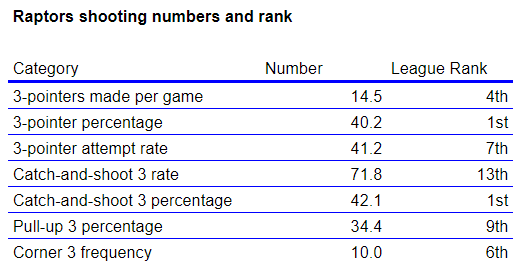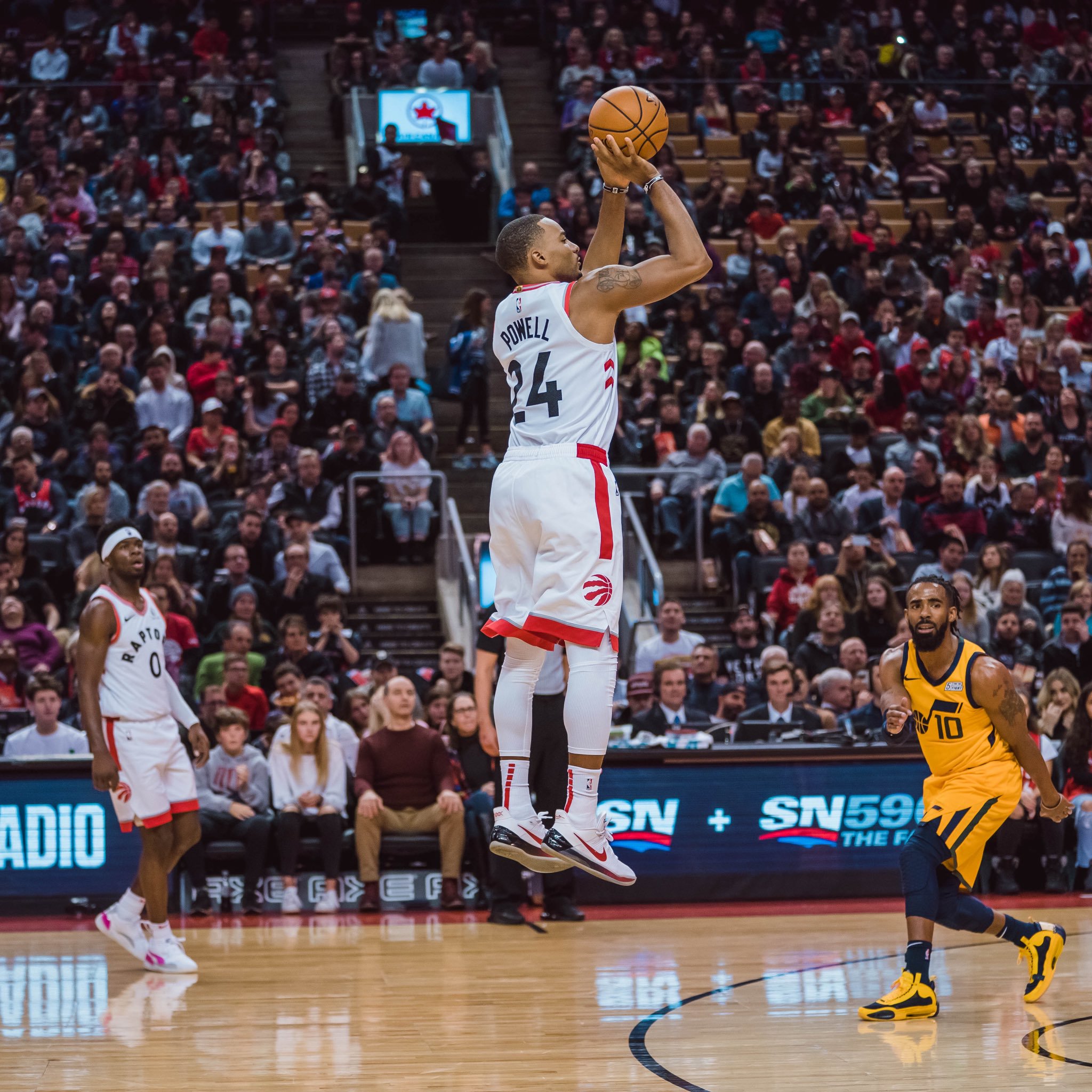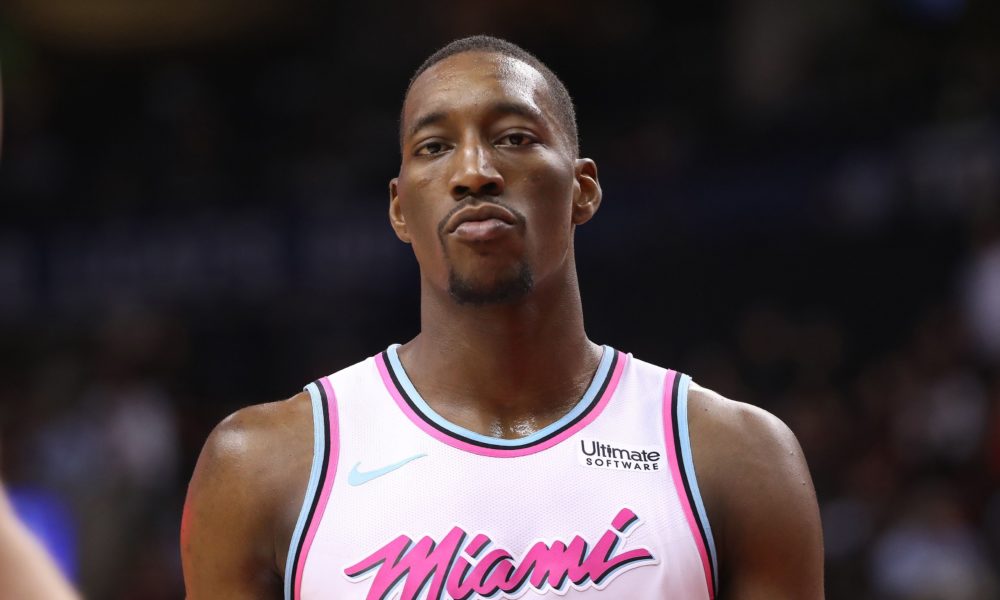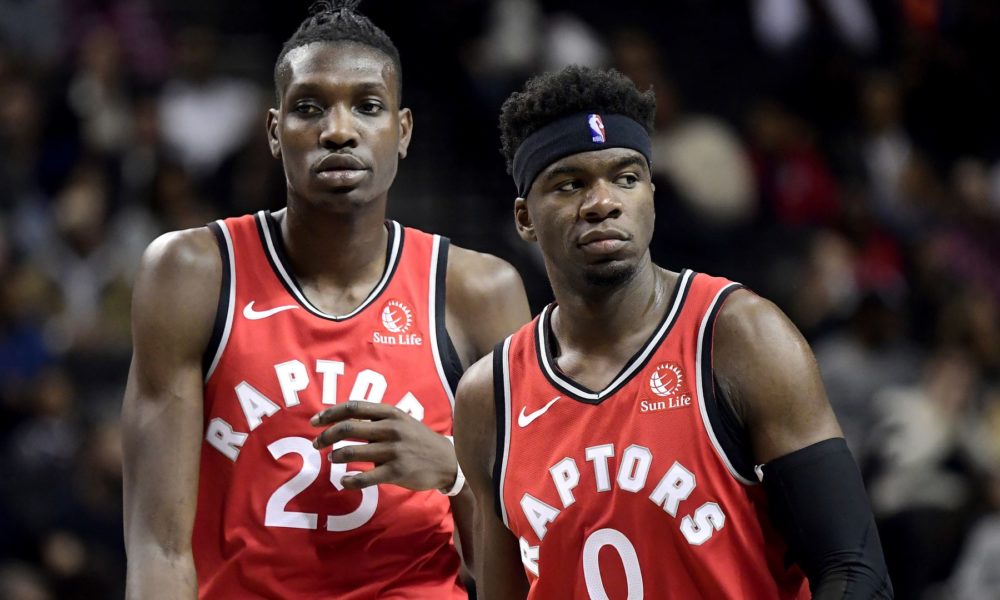This season is full of surprises, but the Toronto Raptors being the best shooting team in the league is right there at the top of the list. Nick Nurse has been asked by media about Toronto’s hot shooting approximately one million times this season, and Nurse has never said he’s surprised. He did say “pleasantly happy” before the Jazz game, effortlessly dodging the trap word of surprise, and then the Raptors went out and shot an outrageous 19-of-36 from deep. Are the Raptors’ shooting numbers for real? Let’s start with the raw numbers at the team level to see what the trends are. The statistics here are taken both from pbpstats dot com and nba stats dot com.

The Raptors are not the best team at creating good 3s. They’re in the middle of the league at taking shots that are open and wide-open. That they’re converting their 3s at such a high rate seems to be more a function of shooter quality than shot quality. Note that within the more predictive categories of shooting — corner 3 frequency and catch-and-shoot frequency, namely — Toronto is good but not at the top of the league.
Why would there be a disconnect?
The easiest answer is that Toronto is a good shooting team but not the best in the league. Following that line of logic, they’re due for some regression to the mean. Shooting numbers, after all, can take a long time to stabilize, as Toronto found out last year when all the makes came in a flood towards the end of the season. There’s more evidence that Toronto isn’t quite as good at shooting as it has been.
No team has shot over 40 percent from deep since the 2015-16 season, when the Golden State Warriors connected on 41.6 percent. Teams defended the 3-point arc very differently back then, and it’s telling that in 2015-16, the Warriors led the league with 31.6 3s attempted per game. That number now would put them 21st in the league, between the Detroit Pistons and Orlando Magic. It’s unlikely that Toronto is the most accurate shooting team since the 2015-16 Warriors, while also taking five more 3s a game than the Warriors did. They almost certainly won’t finish the season above 40 percent, simply as a result of them probably not being the best shooting team in history, in terms of combining frequency and accuracy.
One important point of differentiation is Kyle Lowry’s injury. Lowry has historically not only been Toronto’s best shooter, but also Toronto’s best driver of good shooting; his teammates always shoot better from deep when he’s on the floor. Since 2012-13, when Lowry came to Toronto, the Raptors have shot 37.2 percent from deep with him on the floor and 34.9 percent with him off. And since November 8, when Lowry was diagnosed with a small fracture in his thumb, there’s been no drop-off to the Raptors’ shooting. They shot 40.4 percent from deep before the injury and 40.0 percent after. Because Lowry has historically driven so much of Toronto’s success, it’s fair to wonder if the team has been on a small hot streak since his falling out of the lineup, which would not be a good predictor of future success.
At the team level, there’s plenty of evidence that Toronto is on a 19-game hot streak to start the year. They’re a very good shooting team, perhaps more reasonably projected to shoot ~38 percent from deep, which would be top-five in the league. They may not stay at 40.2 percent on the season. Let’s move to the individual level to test that theory. This chart includes only players who are or could be in the rotation and who attempt 3s (sorry Rondae Hollis-Jefferson and Malcolm Miller).

First, these numbers do not add up to Toronto’s proper 3-point numbers. VanVleet, Siakam, Powell, and others are all taking more 3s per game since Lowry’s injury, and Lowry, of course, fewer even though that’s not reflected in his per-game averages, so the total attempts in the chart above will be inflated. Still, we can compare players’ percentages on the year with their expected percentages. Let’s start with those whom we can rule out without any evidence.
Lowry, VanVleet, Powell, and Gasol are all shooting pretty well what we’d expect from their career numbers. Lowry and VanVleet have been among the best shooters in the league for the past few years, and their numbers reflect that. Don’t expect any negative regression there. Powell is a marksman, and Toronto is confident in his stroke. In fact, as his attempts become easier when Lowry returns to the floor, you can probably expect Powell’s 3-point accuracy to improve slightly, reaching closer to 40 percent. Gasol is a proven shooter, and even if he’s too passive on occasion, he bangs them in when he knows it’s important.
Likewise, Ibaka, Thomas, and Boucher are all just about where logic would have them. Ibaka will probably shoot a little bit better, Thomas perhaps slightly worse, but the three are basically at expected rates.
That leaves the wildcards: Terence Davis, OG Anunoby, and Pascal Siakam.
There is evidence that Davis is a good shooter. He improved every year in college until he was a good shooter at a fairly high frequency in his senior year. Then he got to Toronto, and assistant Jim Sann and company helped fix some of Davis’s mechanical woes, namely balance, foot direction, and arm placement. So if he was a good shooter in college and has improved on his form, is it reasonable to expect him to shoot 44 percent from deep?
Not really, no. Even the best form, if it’s a new addition, needs reps to equate to high accuracy. And Davis has changed his form, which means he won’t be optimized as a shooter for a few years. 44 percent is Steph Curry-level, and Davis is decidedly not there. He’s trustworthy, and Toronto has empowered him to launch freely. He has been on fire, especially since Lowry went down. But Davis will probably stabilize in the mid- to high-30s as the year goes on. He may end up in the low-40s in a few years, but suffice to say he’s on a hot streak to start this year. One study found that shooting accuracy doesn’t stabilize, or isn’t predictive of the future, until approximately 750 attempts. Davis is at 52 attempts on the year. So his numbers are impressive, but don’t be surprised if they shift going forward.
OG Anunoby is another fun test case. His stroke has improved dramatically over the years, from this:
To this:
Anunoby has all but exorcised his old habit of pump-faking when he’s unguarded. His stroke is the same almost every time he shoots. His wrist and lower body are much better in his jumper. His rhythm is excellent, now. So many aspects of his jumper are improved; furthermore, he was a fine shooter, percentage-wise, as a rookie. Most of all, he’s added consistency.
All that said, shooting 47 percent from deep goes beyond consistency. It’s technically possible. Spot-up shooters like Anunoby have shot at that rate over a full season. Joe Harris shot 47.4 percent last year, Kyle Korver 47.2 percent in 2013-14, and Joe Johnson 47.8 percent in 2004-05. Anunoby probably hasn’t reached that level. He still hasn’t reached 750 attempts in his career. Even though his stroke is great, and his numbers have been even better, it’s safe to assume players aren’t Kyle Korver-level spot-up shooters until they do it over a prolonged period of time.
This isn’t to diminish Anunoby’s accomplishments. He’s made huge strides, and he’s become deadly from outside. He is an excellent shooter, and I expect him to remain at or slightly above 40 percent on the year. But 47 percent is pretty obviously a hot streak and won’t be maintained over the year.
Siakam is the most interesting study, in terms of the level of improvement he’s made to his jumper since joining the NBA. I analyzed the historical context to his shooting development in much greater detail here, but suffice it to say that Siakam’s progress has been unprecedented. But are his numbers this year sustainable?
Siakam is shooting 39.0 percent from deep, which on the surface is a replicable number. He’s taking difficult shots, including a ton of semi-contested pull-ups from above the arc, but his stroke has improved a dramatic amount. Even though there are lots of moving parts, both shooting experts Matt Thomas and Malcolm Miller told me that Siakam’s shot has excellent form, molded perfectly to his body type. His teammates and coaches rave about the unbelievable amount of work he’s done to hone his jumper. He’s still short of 750 attempts in his career, but Toronto’s staff members have said for years that his numbers in practice have been excellent, too. I would lean towards Siakam keeping up his 39.0 percent, and even perhaps pushing it higher when Lowry returns and Siakam isn’t asked to take such difficult shots.
So where does that leave us? Doing some rough math, assuming negative regression for Davis and Anunoby to, say, 40 percent from deep apiece, the Raptors would lose 0.3 triples per game. That would leave them at 39.2 percent from deep, which is a more reasonable number. It’s closer to my rough estimate for regression in the team-wide numbers. It would also be the second-best shooting percentage from deep in the league. High, but more reasonable. Not the highest mark since the Golden State Warriors pre-Kevin Durant.
This exercise should make clear how thin the margins are. OG Anunoby missing 0.2 more triples per game, and Terence Davis missing 0.1, doesn’t seem like a whole heck of a lot. It’s not. It adds up to less than one point per game. Seeing as how Toronto hasn’t won or lost a game by one point this year, it’s not even clear if shooting 39 percent versus shooting 40 percent from deep would affect their win total.
That’s the important message. The Raptors may not be the best shooting team in the league, and they may be due for some negative regression. But they’re stocked with great shooters, and most of their good shooting this year seems sustainable. Even if they do regress, it probably won’t change their level of dominance. So are the Raptors this good at shooting? Maybe not quite to this extreme; however, there’s been much more to their 15-4 record than a hot shooting streak. And if the Raptors continue winning, one or two percentage points of accuracy won’t matter much to anyone.



